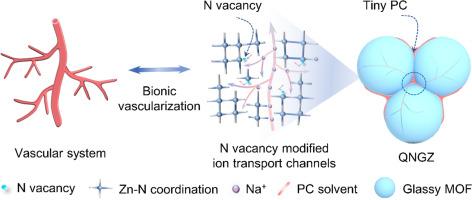Bioinspired design of vascularized glassy metal-organic frameworks electrolyte for quasi-solid-state sodium batteries
IF 20.2
1区 材料科学
Q1 CHEMISTRY, PHYSICAL
引用次数: 0
Abstract
Quasi-solid-state electrolytes (QSSEs) are regarded as the most promising alternative for next-generation battery technology due to the compatibility of assemble process and high safety. However, the rational design of solid hosts to ensure the high-efficiency utilization of tiny liquid electrolytes and the deep understanding of ion transport mechanisms at heterogeneous structures are still challenging. Herein, inspired by the ion transport in biological blood vessels, we propose a nitrogen vacancy modified glassy metal-organic framework (MOF) as Na-ion QSSEs host, which shows multilevel ions transport channels, isotropy property, and no grain boundaries. The vascularized glassy MOF enables the reasonable distribution of a small amount of solvent (14 wt.% (solvent as a percentage of QSSE by mass)) in both macro and microenvironments with specific functions, boosting the fast Na-ion transport (1.18 × 10−4 S cm–1, 30 °C) and Na-ion transfer number (0.92), and homogeneous Na-ion nucleation/propagation even at -50 °C. Meanwhile, the quasi-solid-state Na||Na3V2(PO4)3/C cell demonstrates excellent rate capability and long cycling stability (0.0288 % capacity decay per cycle after 500 cycles). The bioinspired design of glassy MOF will shed light on new avenues for the development of energy storage and conversion.


准固态钠电池用血管化玻璃状金属有机框架电解质的生物启发设计
准固态电解质(QSSE)因其组装工艺的兼容性和高安全性,被视为下一代电池技术最有前途的替代品。然而,如何合理设计固态宿主以确保高效利用微小的液态电解质,以及如何深入理解离子在异质结构中的传输机制,仍然是一项挑战。在此,我们受生物血管离子传输的启发,提出了一种氮空位修饰的玻璃态金属有机框架(MOF)作为纳离子 QSSEs 的宿主,它具有多级离子传输通道、各向同性和无晶界等特性。维管化的玻璃质 MOF 使少量溶剂(14 wt.%(溶剂占 QSSE 的质量百分比))在宏观和微观环境中合理分布,并具有特定功能,从而提高了 Na 离子的快速传输(1.18 × 10-4 S cm-1,30°C)和 Na 离子转移数(0.92),即使在 -50°C 下也能实现均匀的 Na 离子成核/扩散。同时,准固态 Na||Na3V2(PO4)3/C电池表现出卓越的速率能力和长期循环稳定性(500 次循环后每次循环的容量衰减为 0.0288%)。玻璃状 MOF 的生物启发设计将为能源存储和转换的发展提供新的途径。
本文章由计算机程序翻译,如有差异,请以英文原文为准。
求助全文
约1分钟内获得全文
求助全文
来源期刊

Energy Storage Materials
Materials Science-General Materials Science
CiteScore
33.00
自引率
5.90%
发文量
652
审稿时长
27 days
期刊介绍:
Energy Storage Materials is a global interdisciplinary journal dedicated to sharing scientific and technological advancements in materials and devices for advanced energy storage and related energy conversion, such as in metal-O2 batteries. The journal features comprehensive research articles, including full papers and short communications, as well as authoritative feature articles and reviews by leading experts in the field.
Energy Storage Materials covers a wide range of topics, including the synthesis, fabrication, structure, properties, performance, and technological applications of energy storage materials. Additionally, the journal explores strategies, policies, and developments in the field of energy storage materials and devices for sustainable energy.
Published papers are selected based on their scientific and technological significance, their ability to provide valuable new knowledge, and their relevance to the international research community.
 求助内容:
求助内容: 应助结果提醒方式:
应助结果提醒方式:


